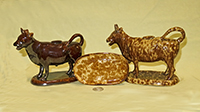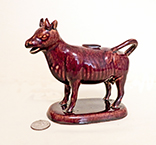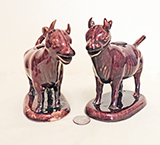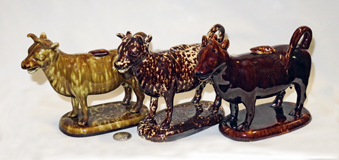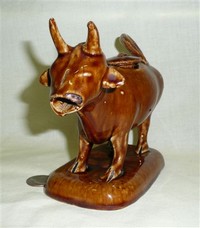Bennington
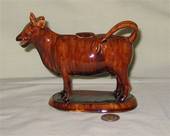
This lidded creamer on an oval base is a fine example of American Rockingham ware, which is the term for
cream or yellow ware that has been dipped or splattered with brown glaze before firing. Rockingham ware was
widely produced in the eastern US in the mid-1800s. This page of the web site should therefore perhaps be
termed “American Rockingham” for the coloring and glaze, but most of these creamers of this style and glaze
are associated primarily with Bennington, Vermont. Vermont is famous for its cows (more of them than
people, they used to brag; friendlier, too, some say.), and I’m a Yankee by birth, so I’ve chosen to use
that term. I have put these creamers in a theme of their own because, whether they were actually made in
Bennington or not (and I strongly suspect most were), they are assuredly early (19c) American pottery, and
as far as I know, the earliest cow creamers made on the US side of the Atlantic.
Here are some examples from my collection, showing the differences in the coloring that was noted by the
National Academy of Art*. The shapes and thus the molds seem quite similar, except for one of the creamers
in the third picture, but no two pieces are identical. Per usual, if some expert can help me more precisely
attribute these creamers, I’d be most appreciative.
The Bennington Museum’s web site notes that “pottery has been made in Bennington since 1785 when Captain
John Norton began to produce utilitarian earthenware and stoneware. The Norton pottery grew throughout the
19th century and gained fame for its brilliantly decorated stoneware featuring flowers, birds, and animals.
Regular pottery production ceased in 1894, though the company operated as a wholesaler until 1911. The
United States Pottery company (1847 - 1858) produced ornamental objects including yellowware with
Rockingham and flint enamel glazes, agate and granite wares, porcelain and parian.” These two potteries
are credited with a prodigious, if relatively short-lived, output of American Rockingham.
*From the National Gallery of Art's website:
“The nineteenth century was a time of experimentation not only with novel forms, but also with a variety
of glazes. Both the Norton and Fenton potteries of Bennington, Vermont, became famous for their
"Rockingham" ware. Typically, Rockingham pottery is covered with a mottled brown glaze, made to
imitate the tortoiseshell appearance of wares produced at the Marquis of Rockingham's pottery in England.
The brown color is part of the glaze itself, which was spattered on the fired clay body. Variations in
color were achieved by applying the glaze more heavily in some spots, thinning it in others, and by
allowing it to streak. The glazing process permitted random and accidental effects; consequently, no two
pieces of Rockingham ware were alike. Although Rockingham ware is associated primarily with Bennington,
other American potteries also produced it. The Bennington pieces, at least until 1856, were exceptionally
fine in finish because a double glaze technique was used. A glossy underglaze was applied to the clay
piece. After an initial firing, the brown Rockingham glaze was spattered on and the piece was fired
again. The result was a final glaze effect of extraordinary depth and brilliance.”
Click on any thumbnail to get a larger picture.
These two are classic Bennington cow creamers, nearly identical but of slightly different size and with somewhat different bases. Both are a nice dark brown and neither has any marks.
|
Here is another image of three of the cow creanrs from the traditional 'Bennington' mold, with very different coloration. The most common seem to be the dark brown ones, and the brilliantly spotted ones afre often pushed as Norton or other early makers. The molds. like in England, myst have passed througn many hanrds.
|

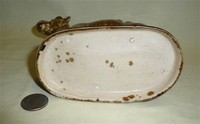 |
I purchased this example (shown also just above with cousins) on eBay, and here is how it was described by the knowledgeable
seller: “1845 VERY Rare SIGNED NORTON COW CREAMER BENNINGTON GREAT COLOR. This is one of the earliest
Bennington Cow Creamers, dating to the 1845-1847 time period. This creamer has a deeply impressed N on
the bottom. Research indicates it was made before Fenton's 1847 mark and the "Bennington"
marks of 1849. Bennington has become a generic term for mottled brown pottery, although it is not a
type of pottery, but rather a town in Vermont. There were 2 important potteries located in Bennington,
Vermont. The Norton Company was established in the 1790's. They were in partnership with Fenton during
a short period of time (1845-47), and that was when this type of Rockingham glaze was used. If this
creamer was made after 1847, it would have had either no mark or a different mark. Fenton opened his
own pottery in 1847 and closed in 1858. Only 1 in 5 items were marked and there were 8 different marks
used. The two most common were an "F" or the 1849 mark which also has the word
"Bennington". It has its fill cap and there are no chips or flakes. It has wonderful color
and form, with a really nice mold strike. The crescent eyes are well defined as well as the ribs going
down from the face to the legs. It also has a well defined hairy end on its tail. One of the horns
might possibly have an old, professional repair at it's base, although we are not entirely sure. There
is a line about ¼" up the tail from the body. This is certainly a nice Norton cow creamer, with
lots of history!” Further, he noted that a 1992 Schroeder’s guide for Bennington states that “ The
Norton Co., founded in 1793, produced mainly redware and salt=glazed stoneware: only during a brief
partnership with Fenton (1845-47) was any Rockingham attempted.”
|
 |
Here is what I consider to be a particularly fine example of Rockingham glaze on the most common form
of Bennington cow creamer.
|
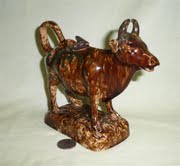 |
This is a beautiful example of yet another form, certainly with Rockingham glaze, and most likely
Bennington. It came to me via sellers who got it at an auction in SE Pennsylvania, where it was said
to date from the early to mid 1800s. In contrast to the others here, it bears a stylized fly on the
lid.
|
 |
These three are similar in shape and style to the one above, but have a very different glaze, which
one seller claimed indicates that they’re Pearlware from around the 1840s. For a while I showed
these on my Staffordshire page, but based on their resemblance to the one above, including the
stylized fly - and the fact that the sellers were all from the eastern US or Canada - I now think
that they’re more likely 19c American. I sure would appreciate advice from an expert on early
American pottery.
|
This creamer is from is yet another quite different mold - these are expanded shots of the one in
the right hand picture in the introduction. Although per usual I have no information from the seller,
I have a suspicion that this one may be from potteries in Pennsylvania rather than Vermont.
|
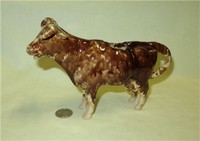 |
This is my only Rockingham Glaze creamer without a base. It’s also unusual in that the lower legs
and hooves are unglazed, and its form is distinctly different than any of the others above. I believe
it to be American – but the only information I have on it is that it belonged to the seller’s
grandmother, who died in 1956.
|
|


